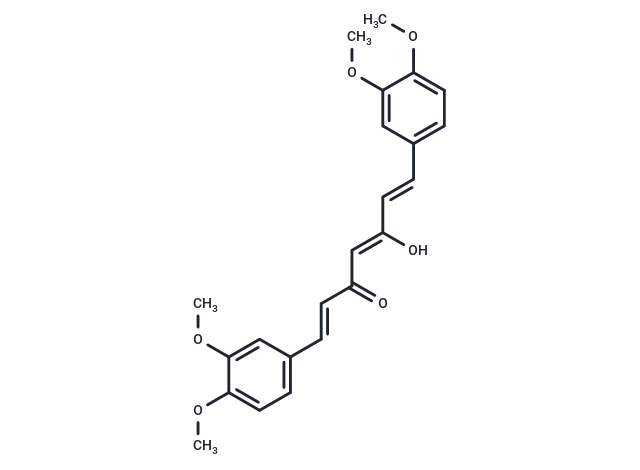Shopping Cart
Remove All Your shopping cart is currently empty
Your shopping cart is currently empty
Dimethylcurcumin (ASC-J9) (ASC-J9) is an androgen receptor degradation enhancer. It effectively suppresses castration-resistant prostate cancer cell proliferation and invasion.

| Pack Size | Price | USA Warehouse | Global Warehouse | Quantity |
|---|---|---|---|---|
| 2 mg | $30 | In Stock | In Stock | |
| 5 mg | $44 | In Stock | In Stock | |
| 10 mg | $68 | In Stock | In Stock | |
| 25 mg | $127 | In Stock | In Stock | |
| 50 mg | $198 | In Stock | In Stock | |
| 100 mg | $318 | In Stock | In Stock | |
| 1 mL x 10 mM (in DMSO) | $48 | In Stock | In Stock |
| Description | Dimethylcurcumin (ASC-J9) (ASC-J9) is an androgen receptor degradation enhancer. It effectively suppresses castration-resistant prostate cancer cell proliferation and invasion. |
| In vitro | Dimethylcurcumin is able to degrade fAR and AR3 in a dose-dependent manner in various human PCa cells. Dimethylcurcumin can also effectively suppress AR-targeted genes in CWR22Rv1-fARKD cells. Dimethylcurcumin (5 or 10 μM) significantly suppresses the DHT-induced cell growth in all three PCa cell lines. Dimethylcurcumin suppresses AR-targeted genes and cell growth by the degradation of fAR and ectopic AR3 in C81 and C4-2 cells [1]. ASC-J9 reduces the AR aggregated AR-112Q in cells. Dimethylcurcumin suppresses the aggregation of AR-112Q in SBMA PC12/AR-112Q cells [2]. |
| In vivo | Dimethylcurcumin (75 mg/kg, i.p.) degrades both fAR and AR3 in the xenografted tumors in vivo and ASC-J9-treated tumors have significantly decreased Ki67-positive cells [1]. Dimethylcurcumin (50 mg/kg every 48 h, i.p.) substantially ameliorates the SBMA symptoms in AR-97Q mice and ameliorates neuromuscular pathological findings [2]. ASC-J9-treated mice show significantly smaller prostate tumor sizes when compared with those receiving classic ADT/castration with little serum androgen [3]. |
| Cell Research | For the cell survival assay, the PC12/AR-112Q and PC12/AR-10Q cells are cultured as described previously and incubated cells in the presence of 10 μg/mL doxycycline for 24 h. Then the cells are treated with a vehicle, 5 μM Dimethylcurcumin or 10 μM Dimethylcurcumin, along with 1 nM DHT, and determined cell viability using Trypan blue staining at specific time intervals [2]. |
| Animal Research | CWR22Rv1 cells (1×10^6 cells per site) are injected into both anterior prostates of the castrated nude mice after 2 weeks of implantation. The mice were randomly divided into two groups (four mice/eight tumors each group) and either receive 75 mg/kg Dimethylcurcumin intraperitoneal injection or vehicle control every other day. After 4 weeks of treatment, all mice are killed to examine the tumor growth. Body weights and mice activity are measured weekly [1]. |
| Synonyms | GO-Y025, ASC-J9 |
| Molecular Weight | 396.43 |
| Formula | C23H24O6 |
| Cas No. | 52328-98-0 |
| Smiles | COc1ccc(\C=C\C(\O)=C\C(=O)\C=C\c2ccc(OC)c(OC)c2)cc1OC |
| Relative Density. | 1.191 g/cm3 |
| Storage | Powder: -20°C for 3 years | In solvent: -80°C for 1 year | Shipping with blue ice/Shipping at ambient temperature. | |||||||||||||||||||||||||||||||||||
| Solubility Information | DMSO: 48 mg/mL (121.08 mM), Sonication is recommended. H2O: Insoluble | |||||||||||||||||||||||||||||||||||
| In Vivo Formulation | 10% DMSO+40% PEG300+5% Tween 80+45% Saline: 2 mg/mL (5.05 mM), Sonication is recommended. Please add the solvents sequentially, clarifying the solution as much as possible before adding the next one. Dissolve by heating and/or sonication if necessary. Working solution is recommended to be prepared and used immediately. The formulation provided above is for reference purposes only. In vivo formulations may vary and should be modified based on specific experimental conditions. | |||||||||||||||||||||||||||||||||||
Solution Preparation Table | ||||||||||||||||||||||||||||||||||||
DMSO
| ||||||||||||||||||||||||||||||||||||
| Size | Quantity | Unit Price | Amount | Operation |
|---|

Copyright © 2015-2025 TargetMol Chemicals Inc. All Rights Reserved.